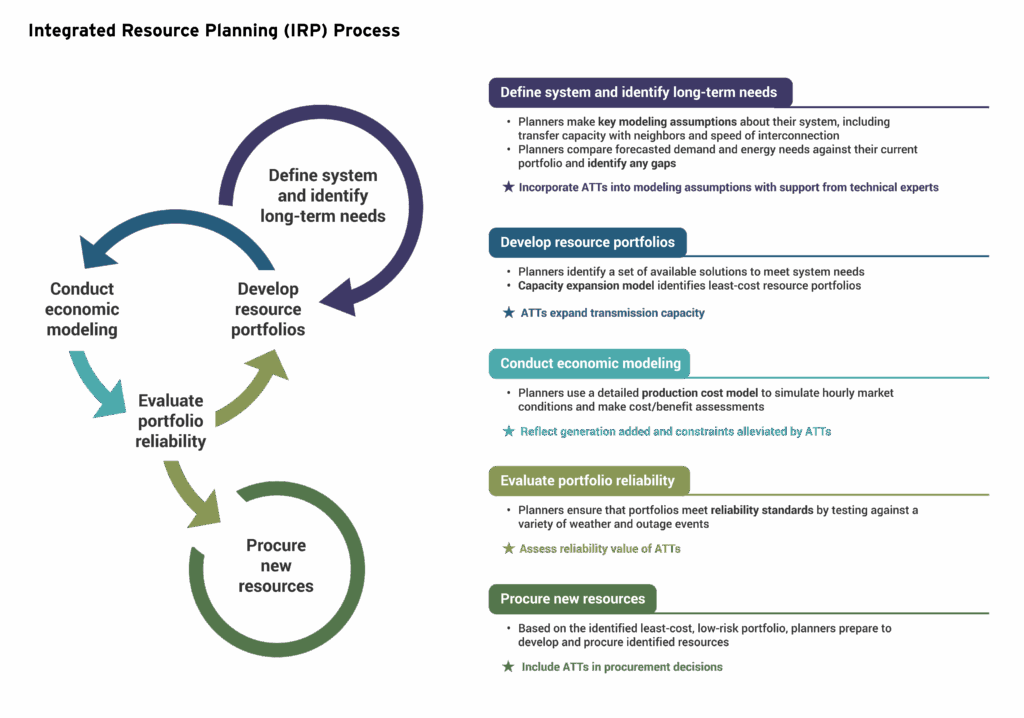As the United States grapples with electricity affordability and meeting soaring demand, both red and blue states have begun to embrace advanced transmission technologies (ATTs) as a valuable tool. ATTs, which include grid enhancing technologies (GETs) and advanced conductors, help utilities deliver more electricity through existing infrastructure by routing power more efficiently and safely through existing lines.
Numerous studies have shown that ATTs can be deployed quickly to reduce consumer bills and accelerate interconnection of cost-effective generation. For example, RMI’s Getting Connected in PJM analysis showed that GETs deployment in five PJM states could accelerate interconnection of 6.6 gigawatts of new generation, saving PJM customers more than $1 billion annually.
As pilots and small-scale deployments continue to demonstrate the benefits of ATTs, state legislators have collaborated across party lines to encourage ATTs. Over the past year, 10 red and blue states (seven with republican governors and three with democratic governors) have passed laws to accelerate deployment, joining six states that already had laws on the books.
To realize the lawmakers’ intended benefits, utilities and the regulators that these laws empower must leverage their vested authority to actually deploy ATT solutions and reduce electric bills.
Snapshot of state ATT laws
window.addEventListener(“message”,function(a){if(void 0!==a.data[“datawrapper-height”]){var e=document.querySelectorAll(“iframe”);for(var t in a.data[“datawrapper-height”])for(var r,i=0;r=e[i];i++)if(r.contentWindow===a.source){var d=a.data[“datawrapper-height”][t]+”px”;r.style.height=d}}});
While the language in state ATT legislation varies, most follow one or more of the following approaches:
- Planning laws require utilities, public utility commissions (PUCs), and/or grid operators to study the economics and feasibility of ATTs during resource and transmission planning. Some laws require ATT deployment if studies show they are cost-effective; others leave more discretion to utilities and regulators. Some planning laws require that ATTs be included in integrated resource plans (IRPs) or require large transmission owners to submit a separate GETs evaluation.
- Siting and permitting laws require PUCs to evaluate ATTs during their considerations of proposed grid infrastructure as part of the Certificate of Public Convenience and Necessity (CPCN) process.
- Cost recovery laws can guarantee that ATT expenditures can be included in rate base for cost recovery. Montana’s advanced conductors law offers a higher rate of return for advanced conductors through “cost-effectiveness” criteria.
- Study requirements require state agencies to examine the impact of ATTs without connecting the study to a particular planning or siting and permitting process.
For most these approaches, regulators have significant freedom on how they implement the new laws. If regulators thoughtfully leverage the tools these laws provide, they can cost-effectively expand transmission capacity and reduce bills, as the legislators intend.
Implementing ATTs in planning processes
To realize the value of ATTs, utilities and regulators must include them throughout generation and transmission planning. Because planning with ATTs is relatively new, utilities may need to upgrade their processes. Fortunately, Quanta Technology recently released an Advanced Transmission Technologies Planning Guide that suggests best practices for integrating ATTs into planning.
As detailed in Quanta’s planning guide, optimal IRP planning incorporates ATTs into modeling assumptions. Quanta recommends an iterative study process that co-optimizes generation and transmission planning and solves for both system reliability and least-cost procurement. In this way, planners can optimize investments inclusive of both ATT costs and benefits.
While implementing Quanta’s suggestions may require utilities to upgrade their planning process and software, those relatively small planning investments should yield significant customer savings given the fast return on investments common with ATTs. For example, a dynamic line rating pilot in AEP’s service territory cost $0.5 million to install and paid for itself in about a month, with a total estimated savings of $11 million. Utilities may benefit from working with vendors and other technology experts to develop ATT modeling assumptions, while referring to analysis of recent successful deployments.
Implementing ATTs in siting and permitting processes
Most new state CPCN laws require state PUCs to consider the prudency of ATTs when evaluating new transmission lines, with the presumption that, in many cases, ATTs will reduce upgrade costs. As an example, using the same transmission towers and right-of-way, advanced conductors can double transmission flows at less than half the cost of building a new line. Given expected demand increases, these deployments will likely provide a quicker return on investment as they help avoid or defer more costly upgrades.
Where CPCN requirements are legislated, state PUCs should require that utilities include cost-benefit analysis in their applications. If that analysis is insufficient, regulators could require utilities to resubmit or revise the submission. If utilities decide not to use ATTs as part of the project, they should be required to explain why ATTs were not selected and provide adequate evidence to support their claim. Transmission owners may seek to avoid using ATTs, due to misaligned incentives created by cost-of-service regulation, which rewards regulated utilities for capital expenditures. Because ATTs are so cost-efficient, they can often be overlooked by utilities. Accordingly, PUCs should be prepared to apply a rigorous evaluation of any utility explanation for avoiding the deployment of ATTs.
PUCs should also consider providing pathways for ATTs to act as a bridge technology for new construction. GETs, such as dynamic line ratings, advanced power flow controls, and topology optimization, can increase system capacity and minimize outage durations when new lines are being constructed. For instance, a study by topology optimization provider NewGrid found that reconfiguration of power flow could reduce the cost of power from $600/MWh to $25/MWh at a congested point while transmission reinforcements were built.
From policy to performance: states must act swiftly to close the implementation gap
If implemented robustly, ATT laws could cut customer costs, relieve congestion, and improve reliability. States that lead on implementation will create blueprints for others to follow, showing how to quickly and cost-effectively unlock no-regrets investments. Passing state ATT laws is a vital first step. Now it’s time to turn policy into performance and deliver the modern grid that the moment demands.
The post How State Regulators Can Utilize the Latest Legislative Trend to Make Electricity More Affordable and Reliable appeared first on RMI.















